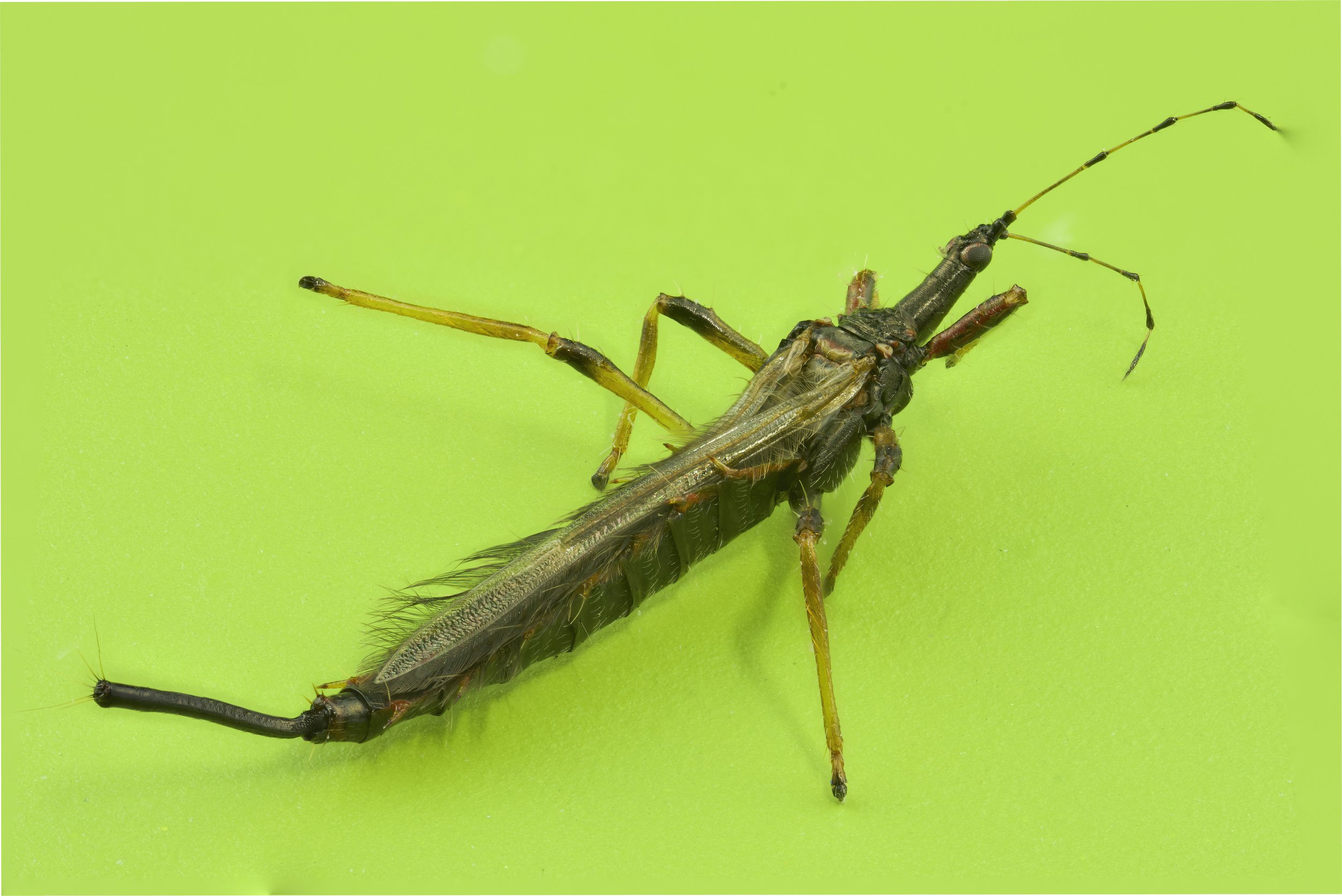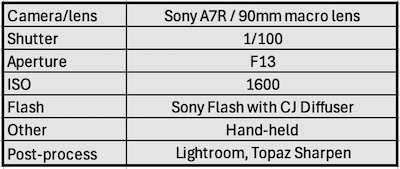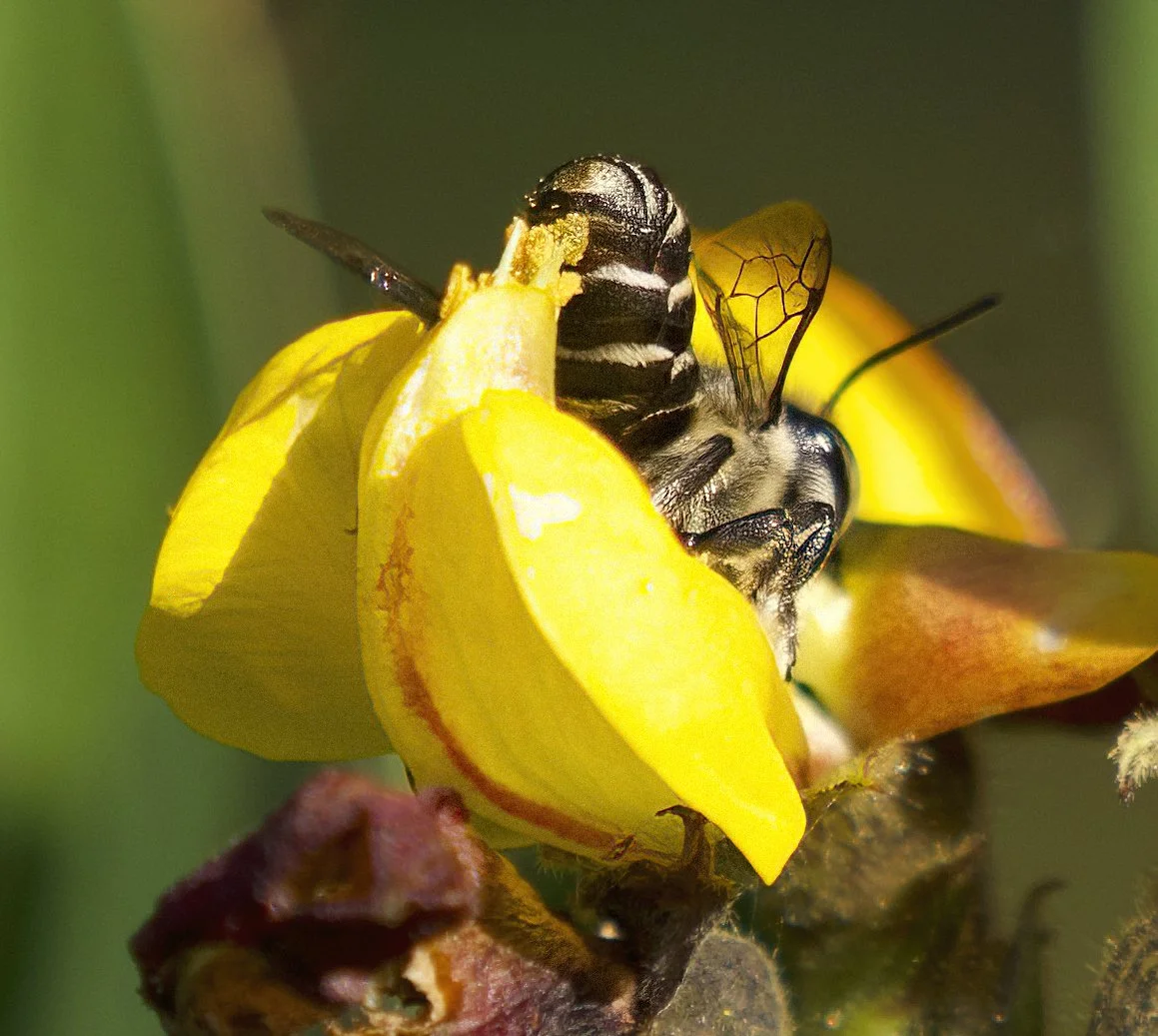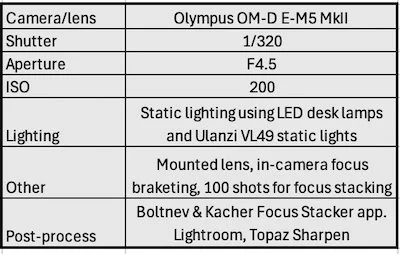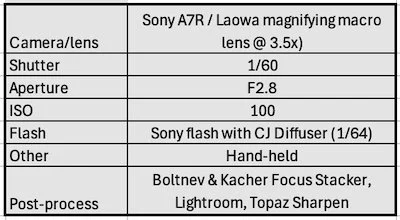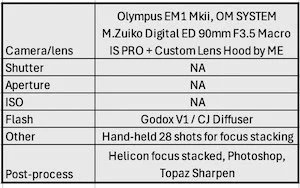Giant Thrips
Idolothrips spectrum
Family: Phlaeothripidae
Suborder: Tubulifera
Order: Thysanoptera
This unusually large member of Thysanoptera has a body length of about 5mm. The photo shows the characteristc narrow wings with a fringe of bristles. that make it an awkward flier. It has a tubular appendage on the end of the abdomen which is a characteristic of the suborder Tubulifera. The photo also shows the lateral barbs the abdomen.
The image is a focus-stacked composite of 38 images collected using a we macro rail. The camera was a Sony A7R4 with a Laowa magnifying macro lens set to 2.5x. Static llighting was provided using LED panel lights though an improvised diffuser made from a polyethylene milk bottle. The focus stacking software used was Boltnev and Kacher’s “Focus Stacker”. Post-process editing was done using Lightroom and Topaz Labs “Sharpen” app.
Aphid
©Phil Warb
Aphis sp.
Family Aphiidae
Order: Hemiptera
This very small aphid (circa 1mm body length) was attracted to a light at night time.
Aphids have tube-like cornicles or siphunculi that resemble cerci, that can be seen in these photos protruding laterally at the posterior end of the abdomen. However the structure is not functionally the same as cerci. Aphid cornicles are used to secrete a range of volatile and non-volatile compounds with a variety of ecological functions. These include alarm pheromones and defensive substances such as waxes and triglyceride glues. They are also associated with secretions that encourage myrmecophily (ant symbiosis).
The image was focus stacked from 83 photos taken with a tube lens and a 5x microscope objective. The photos were assembled using a Wemacro rail to increment the focal points. The focus stacking was carried out using the Bolnev and Kacher “Focus Stacker” app.
Greenbottle Fly
Lucia sp. probably L. cuprina
Family: Calliphoridae
Order: Diptera
This greenbottle fly is also referred to as the Australian sheep blow fly.
On this occasion the fly was moving around too much to allow a stacked image. A single shot photo was required. This was achieved using a macro lens with a small aperture of F13 and a flash. The shutter speed was 1/100. Camera was handheld.
©Phil Warb
Megachile bee pollinating Egg and Bacon Plant
©Phil Warb
Megachile sp.
Family: Megachilidae
Order: Hymenoptera
On Egg and Bacon Plant, in the pea-flower family Fabaceae
Sometimes, it is nice to photograph an insect interacting with its environment. For that, you often won’t get the chance to use a macro lens up close to the event that you are observing. You may need to use a telephoto lens and need to be prepared to take a shot when the opportunity presents.
In this photograph we have an event that is well known but is seldom photographed: the pollination of an ‘Egg and Bacon’ plant.
The Egg and Bacon plants have a remarkable mechanism for pollinating the flowers. When an insect, of appropriate weight, lands on the 'keel' part of the flower, the flower's reproductive organs spring out from the end of the keel, under which they were hidden. Pollen exchange then takes place, at a precise place on the end of the insect’s abdomen. Megachile bees seem to be amongst the pollinators for this plant, and this is borne out by this photographic example. Here the bee had landed on the keel, and we can see the end of the abdomen of the bee brushing against the anthers of the flower collecting pollen. Similarly, pollen from other flowers is transferred to the stigma from the same, very precise, point on the abdomen.
Smaller bees do not trigger the mechanism and introduced European honeybees, Apis mellifera seem not to be attracted to the flowers. Thus, the plant has a very efficient method of transferring pollen to another plant with little waste.
The Megachile genus contains Leafcutter, Mortar and Resin Bees. Worldwide, this is one of the largest genera with 1500 species in 50 subgenera.
Like the Apidae family, the Megachildae family have long glossa (tongues).
Assassin Bug
Ectomocoris ornatus
Subfamily: Peiratinae,
Family Reduviidae.
This was found in Batemans Bay, New South Wales, Australia. The distribution for the species is mainly New South Wales and southeast Queensland.
The shot was taken with Olympus OMD MII with a 30mm macro lens at F4.5 and shutter of 1/320 with the camera mounted in a jig. The shots were collected using in-camera focus bracketing with two passes to collect 100 shots. The image was focus stacked using Boltnev & Kacher's Focus Stacker app.
Assassin Bug Ectomocoris ornatus - Dorsal view
Assassin Bug Ectomocoris ornatus - lateral view
©Phil Warb
Dark-winged Fungus Gnat - Sciaridae
Family: Sciaridae
Order: Diptera
The subject was about 3.2mm long.
The shot was taken handheld using a Sony A7R with a Laowa magnifying macro lens at 3.5x. Shutter speed was 1/60 and aperture was F2.8. ISO was fixed at 100 and I adjusted the aperture and shutter speed until the image was bright enough. Flash was set to manual and strength 1/64. The flash was diffused with a CJ Diffuser.
I took a total of 82 images and stacked them using Boltnev and Kacher's "Focus Stacker" software. Obviously, that is an excess of images for the stack, but necessary when handholding and using a lens with a depth of field in the 10s of microns. The excess ensures that all focus points are covered by at least one of the shots. The B&K app was able to align all 82 handheld images without any problems.
©Phil Warb
Bombardier Beetle - Craig Loechel
Bombardier Beetle ---
These things shoot flaming hot acid!!
If you have heard an auto air freshener go off that is pretty much what this Beetle sounded like when it let off on my friend and I this evening. Had us both entertained for a while. I am so glad I did not handle the one I found earlier. The Gas is fairly warm and can leave burns.
Video on one letting off here
https://news.mit.edu/.../how-bombardier-beetles-produce...
Hows those chompers though!! They feed on other insects etc.
Location , Wodonga , VIC , Australia
Have a nice day
Craig
©Craig Loechel not for use without prior consent
Bombardier Beetle
Bombardier Beetle, Brachinus sp., Carbide.


